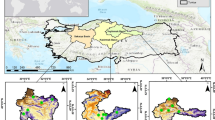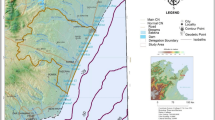Abstract
River channel change is a dynamic process which involves erosion, accretion, lateral migration and changes in its width through the geomorphological process. Shifting of a river causes a direct impact on natural and manmade constructions which are located near the floodplain with consistent damage and devastation of the area. The objective of this study is to analyze the spatiotemporal variation along the Satluj river during the period 1990 to 2019 using Landsat TM, ETM+ and OLI satellite data. Spatiotemporal analysis of the river channel has been carried out to analyze the river channel change morphology, mid-line channel shifting and changes in surface water area of the Satluj river using twenty randomly distributed cross-sections (X1-X20). For surface water area change analysis, the satellite derived normalized difference water index (NDWI) has been used. The obtained results indicates that the river width increased by 0.033 km in overall cross-section (X1–X20) in the year 2019 as compared to the year 1990. Mid-line shifting of the river is mostly towards the left bank of the river. The maximum channel shifting of 1.364 km took place from Chak Bandala village in Jalandhar district to Madarpur village in Moga district between the years 1990 and 2019. However, the NDWI results indicate that the river surface area has been reduced by −90.33 km2 between the years 1990 and 2019. Additionally, the average shifting rate of the Satluj river during the period 1990 to 2019 is by 0.778 km.
Similar content being viewed by others
References
Akhter, S., Eibek, K.U., Islam, S., Islam, A.R.M.T., Chu, R. and Shuanghe, S. (2019). Predicting spatiotemporal changes of channel morphology in the reach of Teesta River, Bangladesh using GIS and ARIMA modeling. Quaternary Internat., v.513, pp.80–94.
Bristow, C.S. (1987) Brahmaputra River: channel migration and deposition.
Din, S.U. (1999) Migration of Yamuna river from Mahabharata period to the present—a remote sensing view. Jour. Indian Soc. Remote Sensing, v.27(2), pp.129.
Goswami, D.C. (1998) Fluvial regime and flood hydrology of the Brahmaputra River, Assam. Mem. Geol. Soc. India, no.41, pp.53–76.
Gupta, V. and Sah, M.P. (2008) Impact of the trans-Himalayan landslide lake outburst flood (LLOF) in the Satluj catchment, Himachal Pradesh, India. Natural Hazards, v.45(3), pp.379–390.
Ham, D. G. and Church, M. (2000) Bed material transport estimated from channel morphodynamics: Chilliwack River, British Columbia. Earth Surface Processes and Landforms. Jour. British Geomorphol. Res. Group, v.25(10), pp.1123–1142.
Hickin, E.J. and Nanson, G.C. (1975) The character of channel migration on the Beatton River, northeast British Columbia, Canada. Geol. Soc. Amer. Bull., v.86(4), pp.487–494.
Jacobson, R.B. and Pugh, A.L. (1997) Riparian-vegetation controls on the spatial pattern of stream-channel instability, Little Piney Creek, Missouri (Vol. 2494). US Department of the Interior, US Geological Survey.
Jain, S.K. (1993) Migration behaviour of river ganga between Allahabad and Buxar using remotely sensed data. Jour. Indian Soc. Remote Sensing, v.21(1), pp.37–43.
Jain, S.K. (2002) Assessment of sedimentation in Bhakra Reservoir in the western Himalayan region using remotely sensed data. Hydrol. Sci. Jour., v.47(2), pp.203–212.
Kumar, S. (2015) Flood risk zoning of Satluj River Basin, Himachal Pradesh, India. Internat. Lett. Natural Sci., v.40.
Lane, S.N. (1997) Linking river channel form and process: time, space and causality revisited. Earth Surface Processes and Landforms. Jour. British Geomorphol. Group, v.22(3), pp.249–260.
Latrubesse, E.M., Stevaux, J.C. and Sinha, R. (2005) Tropical rivers. Geomorphology, v.70(3–4), pp.187–206.
Leopold, L.B. (1973) River channel change with time: an example: address as retiring president of the Geological Society of America, Minneapolis, Minnesota, November 1972. Geol. Soc. Amer. Bull., v.84(6), pp.1845–1860.
Li, L.L. (2007) River channel change during the last 50 years in the middle Yangtze River, the Jianli reach. Geomorphology, v.85(3–4), pp.185–196.
McFeeters, S. K. (1996) The use of the Normalized Difference Water Index (NDWI) in the delineation of open water features. Internat. Jour. Remote Sensing, v.17(7), pp.1425–1432.
Montgomery, D.R. (1997) Channel-reach morphology in mountain drainage basins. Geol. Soc. Amer. Bull., v.109(5), pp.596–611.
Pati B.R., Oinam, B., Patel, N.R., Sharma, N., Kandwal, R. and Hazarika, M.K. (2008) Spatio-temporal shift of western bank of the Ganga river, Allahabad city and its implications. Jour. Indian Soc. Remote Sensing, v.36(3), pp.289–297.
Rokni, K., Ahmad, A., Selamat, A., & Hazini, S. (2014). Water feature extraction and change detection using multitemporal Landsat imagery. Remote Sensing, v.6(5), pp.4173–4189.
Statistical Abstract of Punjab 2016 and 2020.
Surian, N. (1999). Channel changes due to river regulation: the case of the Piave River, Italy. Earth Surface Processes and Landforms. Jour. British Geomorphol. Res. Group, v.24(12), pp.1135–1151.
Thomas, A. and Sharma, P.K. (1998). The shift of Ravi River and the geomorphological features along its course in Amritsar and Gurdaspur districts of Punjab. Jour. Indian Soc. Remote Sensing, v.26(1–2), pp.57–68.
Vijender, M. (2019) Floods in Punjab, India, Case Study. Internat. Jour. Res. Analytic. Rev., v.6(1), pp.145x–153x.
Wang S., Fu, B., Piao, S., Lü, Y., Ciais, P., Feng, X. and Wang, Y. (2016) Reduced sediment transport in the Yellow River due to anthropogenic changes. Nature Geoscience, v.9(1), pp.38–41.
Acknowledgement
Authors would like to thank GWG & IT division of Punjab Remote Sensing Centre for their kind support in providing IT infrastructures and facilities. Authors would also like to thank Mr. Ajit Singh, National Centre for Polar and Ocean Research, Goa for his help in feedback on several drafts of this paper.
Author information
Authors and Affiliations
Corresponding authors
Rights and permissions
About this article
Cite this article
Sharma, R., Patel, S., Litoria, P.K. et al. Changes in River Channel Dynamics of the Satluj River, Punjab: Using a Geospatial Approach. J Geol Soc India 98, 1283–1289 (2022). https://doi.org/10.1007/s12594-022-2163-2
Received:
Accepted:
Published:
Issue Date:
DOI: https://doi.org/10.1007/s12594-022-2163-2




